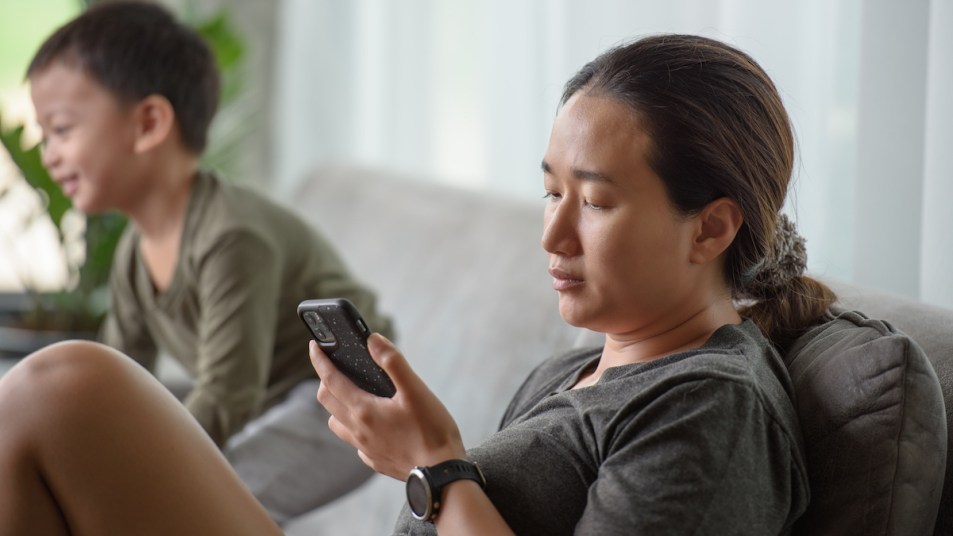Attention Parents: Science Says Your Phone Is Stressing Your Kids — Here’s How To Change That
A parenting pro shares her helpful tips.

If you have kids or grandkids, you’re familiar with the screen time struggle. It was hard enough limiting TV time, but laptops and smartphones — and all the videos, games, and social channels they offer — have made it harder than ever to engage with kids beyond tech.
As it turns out, screen time isn’t just an issue for kids. Laura Linn Knight, a parenting educator, mindfulness advocate, and author of the book Break Free From Reactive Parenting, says the issue is just as prolific among parents. She believes that inspiring kids to reduce their screen time requires parents first take accountability for their own.
We asked Knight to share her strategies for reorienting our focus — shifting it away from our phones and towards more meaningful family bonding. Here’s what she had to say.
Our phones cause us to overreact.
A recent study published in Computers in Human Behavior found that while certain elements of media are indeed beneficial for “caregivers” (or parents), it can also have harmful effects. Some caregivers admitted that when they were absorbed in device use, they sometimes responded to children’s “attentional bids” with “stronger reactions such as anger or annoyance.”
What is reactive parenting?
These stronger responses yield what Knight calls, “reactive parenting.” While raising kids comes with plenty of difficulties, giving in to reactive behavior like yelling or punishment can cause existing issues to mushroom and actually create more problems. Knight notes that phones trigger dopamine release in the brain, and likens their addictive potential to that of gambling and alcohol. She notes that when checking email, sending texts, and scrolling social media, parents “are being lured into screens instead of spending… time with their children.” In this state, parents aren’t as attuned to their kids’ emotional needs — “you’re with your kids, but you’re not actually spending time with them,” she says. It’s this constant state of stimulation that can put parents on edge, making them more reactive and impatient.
How To Put Down Your Phone
Now that we’ve defined reactive parenting, the challenge is how to avoid it. Being a present caregiver can be difficult when your phone keeps lighting up. Here, Knight shares three tips for managing your relationship with your device and focusing on the things in life that matter most.
Awareness is key.
Phone addiction may feel like an impossible habit to break. That’s due, in part, to their perks — easily contacting older children when they’re out; reconnecting with old friends on social media; replying to work emails on the go. Cutting back on screen time, however, doesn’t require forsaking these perks. According to Knight, it’s all about awareness. “Ask yourself, ‘how much time am I spending on my phone?’” she suggests. (The answer may shock you.)
- iPhone users can find out by enabling the phone’s Screen Time feature. (Simply go to Settings, then Screen Time, and tap This Is My iPhone.) Once it’s set up, you’ll get notifications alerting you to how many hours a day you’re spending on your phone, which you can check in Settings. They’ll even include a helpful graph of how you spend your time.
- Android users can see the same by going to Settings and choosing Digital Wellbeing and Parental Controls. Once there, hit Dashboard and choose Screen Time. As with the iPhone, you can see a graph of how much time you spend on screen and how much you’re using different apps. Note that Android settings may vary depending on the model of your phone.
“A lot of parents don’t even realize they’re doing it. They might be in the same room as their child, but they’re also checking their work emails — or they’re cooking dinner with their child, but they’re scrolling through social media,” Knight says.
To check your screen time awareness, ask yourself three questions:
- Where’s my device?
- How am I interacting with it when I’m in front of my child?
- How do I make time and space to put it away at home?
Social media feeds refresh endlessly, and emails never stop coming. This gives the phone a sense of urgency, which is why it’s crucial to slow down and be aware of how we’re prioritizing our attention.
Knight also suggests using one charging station for the whole family that’s in a designated area where phones can be put away. If your phone isn’t at arm’s length all the time, you’ll be less likely to reach for it.
Prioritize family time.
Once you’re aware of how much time you’re spending on your phone, you’ll want to think about what your free time at home actually looks like. These days, everyone is busy — our kids included. But Knight says it’s important to be intentional about spending one-on-one time with your kids, especially if you have a bigger family. “Take that time to put things away and sit with your child and be part of their world,” she says. It will bring you closer together, and ultimately feel better than refreshing your social media feeds.
Once we’ve gotten ourselves off the phones, the issue becomes getting our kids off of theirs. “The best way we can have a conversation with our child and have boundaries, and use our parenting tools, is by being connected with them,” Knight says. She stresses the importance of making kids feel loved, seen, and heard, and remaining calm rather than reactive. Parents, she observes, often skip the step of working on their own behaviors and habits, and instead place blame on their kids. By improving our own relationship with screens, we’ll be better equipped to communicate screen time boundaries with our children in an informed and positive way.
Try family-friendly mindfulness techniques.
In Knight’s opinion, kids are never too young to start practicing mindfulness. Children may not have the patience to meditate for long periods, but there are several approachable methods you can use to slow down as a family. One of these is simply turning on the sink and letting the water run over your hands. “Feel the sensation of the water and notice the temperature,” Knight advises. “Take breaths while you’re in that moment. It can be therapeutic, because you’re tuning into something and showing your child an easy way to de-stress.”
Another mindfulness technique Knight says works wonders with younger kids is laying on the floor together and placing stuffed animals on your stomachs. Use your breath to make the stuffed animals move up and down. This cute exercise forces parent and child to breath deeply.
To stay in the moment instead of getting sucked into the screen, ask your child simple but grounding questions: “‘What do we hear right now?,’ ‘What do we see right now?,’ ‘Is there something around us that we can touch?,’ ‘How does it feel?,’” Knight recommends.
The Bottom Line
Clearly, putting away our phones can have big benefits. Doing this may be tricky at first, but Knight’s exercises offer a great way to ease into a less phone-centric routine. And best of all, she says these techniques don’t just help with managing screen time — they can also ease tantrums and help strengthen parent-child bonds. No matter your age, “coming back to the senses in the present moment is so powerful.”













